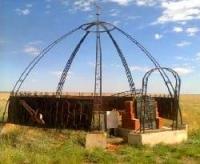You are here
Tilep Aspantayuly grave.


Tourism in Kazakhstan.
"...Notice to yourself when they rush wildly
In the steppes, herds of young horses
A dashing herd - they gallop madly,
They roar and laugh - then the blood plays in them.
Hot. But once they hear
nly the sound of a trumpet or some other
The sound of music - rooted to the spot
Instantly everything, and a wild look
Under the power of a lovely melody
It will pass into humility and meekness..."
Shakespeare W.
Travels across Kazakhstan and Central Asia.
The grave of Tilep Aspantayuly is located at an altitude of 153 meters above sea level, located northwest of the Sazymbai sands, in the Karasu rural district, 7.6 kilometers to the east and slightly south of the abolished village of Shokyrkul, 37.2 kilometers to the southeast from the village named after Akhmet Baitursynuly (formerly the village of Karasu), 8.4 kilometers from the administrative border of the Kostanay and Ulytau regions, 12.4 kilometers north-west of the abandoned winter road Bolshoy Sazymbai in the Dzhangeldy district in the southernmost part of the Kostanay region.
The famous kobyzshy and healer Tilep Aspantayuly (1757 - 1820) was born and lived in the vicinity of Torgay. Tilep Aspantayuly was born and lived in the vicinity of Torgai. At the age of 13, he began to play the kobyz. He made a great contribution to the Kazakh musical art.
Until our time, only three kuys of the author have survived, which are included in the golden fund of the musical heritage. Now they are performed at various competitions. Among the people, Tilep Aspantayuly was also known as a folk healer, a clairvoyant.
The sacred black kobyz, with the help of which he treated people, has been preserved to this day and is passed down from generation to generation. Descendants pass on that the spirit of Tlep has not disappeared, but guards their family.
But Tlep is known not only as bucks. Musically, he is interesting as a composer. According to the memoirs of descendants, Tlep musical compositions were often accompanied by poetic texts. Tlep surviving poetry is negligible.
His following Cuis have come down to us: the life-philosophical work “Tolgau”, the religious content “Allam Zhar” and “Baksy” (about the miraculous creations of shamans). His kyui "Tolgau", "Allam zhar", "Baqsy" entered the golden fund of culture.
Tilep Aspantayuly received a blessing from the famous Baksy Koilybay. The legend about the origin of his kyui "Baksy" is described in Nesipbek Aituly's poem "Tilep pen Sarykyz", as well as the special fate of the young man Tilep became the basis of the drama of the same name.
Having met the baksy for the first time, Tilep becomes a witness of the healing power and power of the sounds of the magic kobyz. He decides to stay with the healer and her daughter Sarykyz to learn how to play the kobyz. He seeks to give good to the hearts of people.
Despite the fact that his father Aspantai left his homeland with the army, he comes to the decision to master the art of baksy. Years pass, friendship between Tilep and Sarykyz develops into love. Having mastered the art of healing with music, Tilep parted with the bucks.
The lovers hardly said goodbye. Tilep went on a long journey with his father. In one of the battles, the forces of evil won and the bucks also die in this battle. Tilep will inspire the army with sounds, the game of kobyz, will give them strength for victory.
Unfortunately, the search for his beloved Sarykyz was not successful for him, the evil forces separated them. Tilep's loneliness was brightened up only by the music of kobyz. He will revive his love for centuries with the sounds of a magical kobyz.
Until now, sick and childless people come to the place of his burial, spend the night at the grave, asking for his blessing.
Legend about Tilep Aspantayuly.
“Several legends have come down to us, telling about his skillful possession of kobyz. So, in one of them it is said that once Tilep rode on his camel named Boz-Ingen. It was in the spring. The Uly-Zhylanshyk River overflowed so that it was impossible to get to the other side.
Suddenly he looks at the bucks, and on the other side is the one - the wedding. The people of Tlep saw and shouted to him:
- Here, dear Tilep, we cannot invite you to our holiday. Interferes with the flood. How to be? “It’s okay,” the musician reassured them.
- You put the yurt separately. Hammer the pegs on four sides and tie it tight. Cover the table.
The people did as Tlep asked them to. At this time, he began to play. Suddenly the wind rustled, a black cloud appeared, which picked up the yurt and carried it to the musician. He ate, thanked the hospitable hosts, and to the sounds of the kobyz, the cloud moved the yurt to its place.
When the aged bucks felt the approach of death, he asked his compatriots to bury him in the place indicated by his faithful companion, the camel Boz-Ingen. She stopped at an old cemetery, not far from the grave of Sary-kyz, a kobyzist girl who passed away early. But the memory of the baksy carefully kept memories of her. His grave has been preserved to this day.”
Geographic coordinates of grave and mausoleum of Tilep Aspantayuly: N48°40'34.67" E64°20'11.03"
Authority and photos:
https://kraeved-kst.kz/int-map/ru.php
Sapar Yskakov. https://www.facebook.com/sapariskakovofficial/posts/682314405542125/
http://muzei-torgai.rka.kz/ru/o-region/sakralnye-mesta/130-mesto-zakhoroneniya-kobyzshi-tilepa-aspantajuly.html







